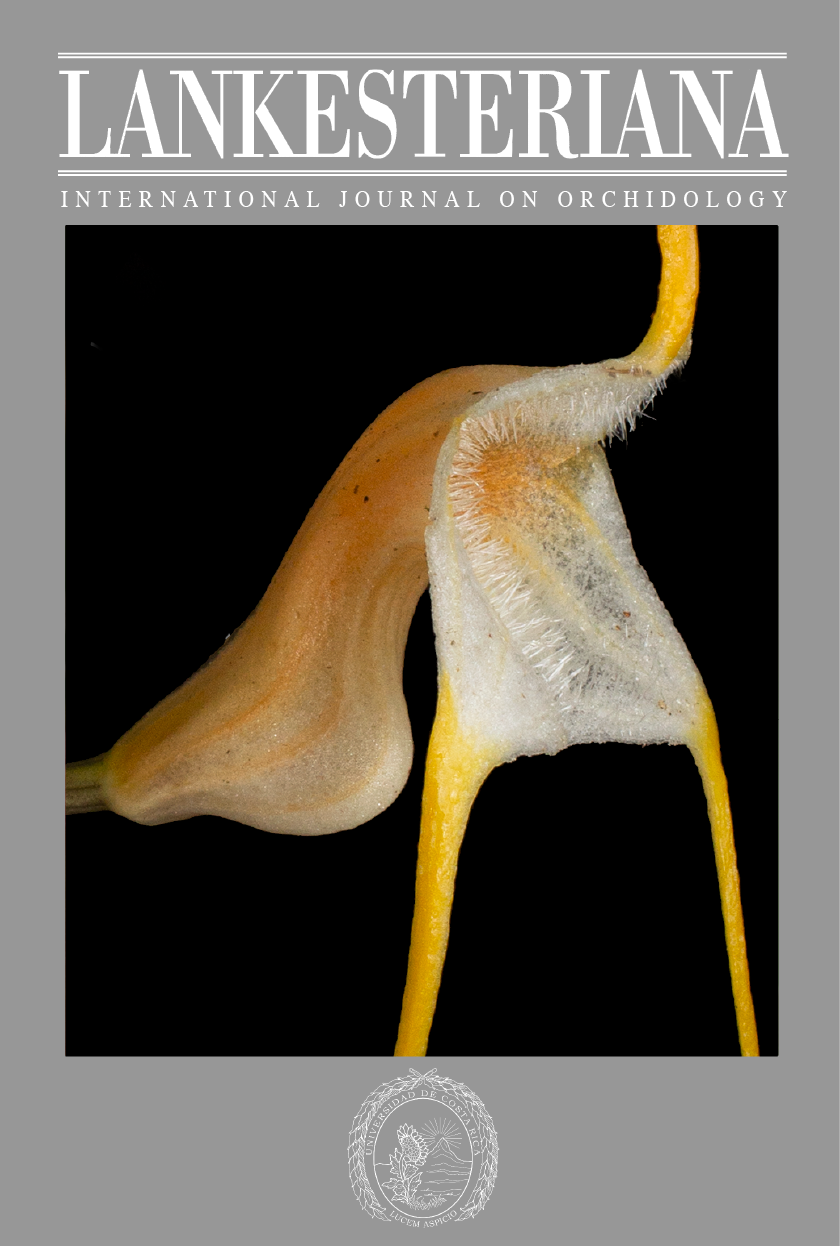<i>Masdevallia leonor-baeziana</i> (Orchidaceae: Pleurothallidinae): new species from the Andean-Amazonian foothills of Caquetá, Colombia
DOI:
https://doi.org/10.15517/lank.v23i2.54019Keywords:
Amazonia, Andes, biodiversity, foothills, neotropicsAbstract
We describe and illustrate a new species of Masdevallia from the Andean-Amazonian foothills of Caquetá, Colombia. Masdevallia leonor-baeziana belongs to Masdevallia subsect. Saltatrices, within the M. constricta group. It is most similar to M. constricta, but it can be distinguished by the shorter sepals and sepaline tails that do not surpass the tube length, and the shorter, sigmoid-ovate lip. We proposed categorizing the species as Critically Endangered (CR) based on the B and D IUCN red list criteria.
Downloads
References
Armenteras, D., Rudas, G., Rodríguez, N., Sua, S. & Romero, M. (2006). Patterns and causes of deforestation in the Colom- bian Amazon. Ecological Indicators, 6(2), 353–368. https://doi.org/10.1016/j.ecolind.2005.03.014
Bernal, R., Gradstein, S. R. & Celis, M. (eds.). (2019). Catálogo de plantas y líquenes de Colombia. Bogotá: Instituto de Ciencias Naturales, Universidad Nacional de Colombia. http://catalogoplantasdecolombia.unal.edu.co
Bogarín, D., Oses-Salas, L. & Smith, C. M. (2017). Masdevallia luerorum (Orchidaceae: Pleurothallidinae), a new species from Costa Rica. Lankesteriana, 17(2), 235–244. http://dx.doi.org/10.15517/lank.v17i2.30100
Bogarín, D., Pérez-Escobar, O., Karremans, A. P., Fernández, M., Kruizinga, J., Pupulin, F., Smets, E. & Gravendeel, B. (2019). Phylogenetic comparative methods improve the selection of characters for generic delimitations in a hyperdiverse Neotropical orchid clade. Scientific Reports, 9, 15098. https://doi.org/10.1038/s41598-019-51360-0
Collantes, B., Incahuaman Atausinchi, F., Córdova Valer, J. Cobos Paucar, E. & Martel, C. (2021). Masdevallia bastantei (Orchidaceae), a new species from Machupicchu, Peru. Systematic Botany, 46(3), 732–738. https://doi.org/10.1600/03 6364421X16312067913453
Hoffmann, C., García-Márquez, J. R. & Krueger, T. (2018). A local perspective on drivers and measures to slow deforestation in the Andean-Amazonian foothills of Colombia. Land Use Policy, 77, 379–391. https://doi.org/10.1016/j.landusepol.2018.04.043 Galindo-Tarazona, R., Haelterman, D., Aguilar, D. L. M. & Zuluaga, A. (2021). A New Masdevallia From South-Western
Colombia (Orchidaceae: Pleurothallidinae). Phytotaxa, 502(3), 277–282. https://doi.org/10.11646/phytotaxa.502.3.5 Gutiérrez del Pozo, D., Jiménez, M. M., Vélez-Abarca, L. & Baquero, L. E. (2022). A new Masdevallia (Orchidaceae: Pleurothallidinae) from the Ecuadorian Amazon foothills of the Llanganates mountains. Phytotaxa, 552(3), 191–200.
https://doi.org/10.11646/phytotaxa.552.3.3
IUCN. (2022). Guidelines for using the International Union for Conservation Nature Categories and Criteria – Version
1. Standards and Petitions Committee. https://www.iucnredlist.org
Karremans, A. P. (2016). Genera Pleurothallidinarum: an updated phylogenetic overview of Pleurothallidinae. Lankesteriana,
, 219–241. https://doi.org/10.15517/lank.v16i2.26008
Karremans, A. P. (2019). To be or not to be a Stelis. Lankesteriana, 19(3), 281–343. https://doi.org/10.15517/lank.v19i3.40082 Karremans, A. P. & Vieira-Uribe, S. (2020). Pleurothallids: Neotropical Jewels, vol. 1. Quito: Imprenta Mariscal.
Luer, C. A. (2002). Icones Pleurothallidinarum XXIII. Systematics of Masdevallia, Part four, Masdevallia, subgen. Masdevallia,
sect. Masdevallia, subsect. Caudatae, subsect. Oscilantes, subsect. Saltatrices (Orchidaceae). Monographs in Systematic
Botany from the Missouri Botanical Garden, 87, 781–1047.
Luer, C. A. (2003). Icones Pleurothallidinarum XXV. Systematics of Masdevallia, part 5. M. subgenus Masdevallia, sec-
tion Masdevallia, subsection Coccineae, section Racemosae, section Triotosiphon, M. subgenus Amanda, M. subgenus Cucullatia, M. subgenus Fissia, M. subgenus Meleagris, M. subgenus Nidifica, M. subgenus Scabripes, M. subgenus Teagueia and M. subgenus Volvula. Monographs in Systematic Botany from the Missouri Botanical Garden, 91, 1–282.
Monteros, M. F., Mogrovejo, A. L., Iturralde, G. A. & Baquero, L. E. (2022). Masdevallia purocafeana, a new species of Orchida- ceae from Cordillera del Toisán, northwestern Ecuador. Phytotaxa, 547(3), 223–231. https://doi.org/10.11646/phytotaxa.547.3.1 Pessoa, E. & Karremans, A. P. (2022). A New Masdevallia (Pleurothallidinae: Orchidaceae) from the White-Sand Forests of the Central Amazon, Brazil. Systematic Botany, 47(1), 293–298. https://doi.org/10.1600/036364422X16442669847094 Pridgeon, A., Cribb, P. Chase, M. W. & Rasmussen, F. N. (2005). Genera Orchidacearum, vol. 4: Epidendroideae. Oxford:
Oxford University Press.

Published
Versions
- 2023-06-20 (2)
- 2023-06-20 (1)
How to Cite
Issue
Section
License
Copyright (c) 2023 Lankesteriana: International Journal on Orchidology

This work is licensed under a Creative Commons Attribution-NonCommercial-NoDerivatives 3.0 Unported License.
According to the Open Access policy promoted by the University of Costa Rica, all the papers published by Lankesteriana are licensed under the Creative Commons copyright and can be downloaded free of charge. The journal holds copyright and publishing rights under the CC BY-NC-ND 3.0 CR license.
Before the publication of the materials submitted by the author(s) in LANKESTERIANA, the author(s) hereby assign all rights in the article to the Lankester Botanical Garden.




